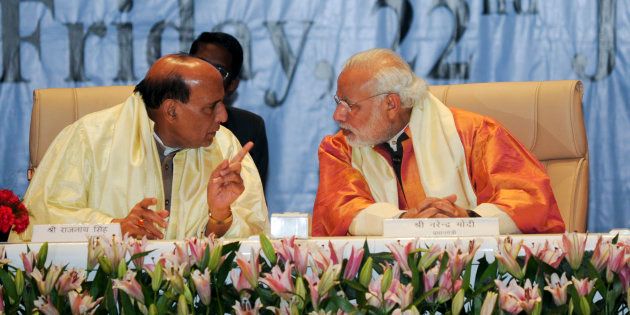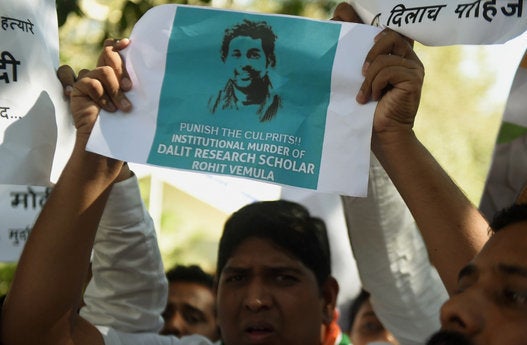
Rajnath Singh's speech in Parliament during a debate on the recent atrocities on Dalits, quivering with heartfelt emotions, was worthy of an episode on The Oprah Winfrey Show. Except there was no one to shed tears during it. Not even crocodile tears.
At the end of the five-hour-long debate, Singh's summary of the situation was riddled with contradictions and coated with layers of irony.
When the Opposition pointed out that Prime Minister Narendra Modi hadn't spoken on the issue in Parliament yet, Singh was ready with a retort. "Has the prime minister spoken on every single issue?" he asked, indicating there are hierarchies in the PM's roster of concerns and that more important matters will get precedence over others.
Fair point.
No, indeed, the PM hasn't spoken up on the spate of injustices against Dalits in Parliament—which means it wasn't on the list of his priorities until recently. The incident of a man killed a year ago by a lynch mob on the suspicion of keeping and consuming beef in his home in Dadri, Uttar Pradesh, was okay. So was the flogging of Dalit youths in Una, in his home state of Gujarat. But then, matters started getting out of hand. The Dalits rose in rebellion, dumped cow carcasses in front of a collectorate, began to take out rallies to demand their rights.
So he did the least he could — he reprimanded the bad gau rakshaks (cow protectors), the torturers of Dalits and other minorities (as opposed to the good ones, who spend their lives toiling over the well-being of the most endangered species in India) in a public forum. But clearly it wasn't enough for the Opposition — such meanies — so it was left to Singh to defend the PM.
Singh further pointed out, with great aplomb, that Dalits have been ill-treated for centuries, considered untouchable, and denied access to basic living resources as well as to places of worship, but "they have never raised the demand for a separate country... their patriotism is unquestionable". So, unlike certain other communities who shall not be named but are frequently told to go live across the border, Dalits are not "anti-nationals"—as long as their dietary habits don't cross a line.
Last, but not the least, Singh reminded the Opposition that this was not the time for one-upmanship or playing a blame game, before proceeding to do so himself. It was grossly unfair, he said, to accuse the National Democratic Alliance (NDA) government, led by the Bharatiya Janata Party (BJP), of having a poor record of crimes against Dalits. He cherry-picked two years to compare — 2013 and 2015 — to show a decline in such incidents. NDA came to power under Modi in 2014. The Home Minister is right about the decline. There has been a marginal 2% decline in the recorded crimes against Dalits between 2013 and 2015. But as the graph below shows, a longer time frame reveals a very different picture. And 2015 is still the third highest year in terms of the incidence of crimes against scheduled castes since 2001.
Surely we are still only scratching the surface.
Of the thousands of Dalits who are tortured, killed, hounded and ostracised every year, how many have the means to make themselves heard? Even if they are brave enough to complain to the authorities, how many can successfully register cases with the police? And in case the police are noble enough to take notice of their grievances, how many have any hope of real justice? Can social justice be measured in hard numbers? What kind of justice would alleviate the shame and indignity of a public flogging or being urinated on or seeing one's relations being raped, anyway?
Whatever the statistics may say in terms of year-to-year figures for registered cases of Dalit atrocities, the fact remains that media reporting on such crime has stepped up over the last few months. Apart from mainstream media, the ubiquitousness of the mobile phone equipped with a video camera means that graphic visual evidence of brutalities, first shared as the trophy for the hunt, are flooding social media.
Many of the perpetrators have voluntarily made a display of their act of bravado — by posting these photographs and video footage on social media and WhatsApp groups. Ironically, their arrogance has been their undoing, slapping them back in their faces by exposing their inhumanity to the world at large and enabling a scope for justice.
So is the State only worried that such acts of cruelty are happening in the 21 century — as Singh seems to be saying to his fellow Parliamentarians? Or is the bigger headache over the fact that these are now finding ways of reaching the public eye which were hitherto not available during a technologically less evolved time?
Vast numbers of Dalits and other minorities still find it difficult, if not impossible, to stake a claim on their constitutional rights via the lawful custodians of such rights. But there are, at least, now ways of getting around the obstacles that were unthinkable only just a decade ago.
Also read on HuffPost
